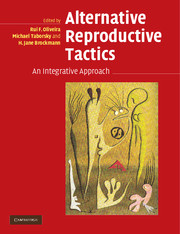Book contents
- Frontmatter
- Contents
- List of contributors
- Preface
- 1 The evolution of alternative reproductive tactics: concepts and questions
- PART I ULTIMATE CAUSES AND ORIGINS OF ALTERNATIVE REPRODUCTIVE TACTICS
- PART II PROXIMATE MECHANISMS OF ALTERNATIVE REPRODUCTIVE TACTICS
- 5 The roles of genes and the environment in the expression and evolution of alternative tactics
- 6 Neuroendocrine mechanisms of alternative reproductive tactics: the chemical language of reproductive and social plasticity
- 7 Hormones and alternative reproductive tactics in vertebrates
- PART III TAXONOMIC REVIEWS OF ALTERNATIVE REPRODUCTIVE TACTICS
- PART IV EMERGING PERSPECTIVES ON ALTERNATIVE REPRODUCTIVE TACTICS
- Index of species
- Subject index
- References
5 - The roles of genes and the environment in the expression and evolution of alternative tactics
Published online by Cambridge University Press: 10 August 2009
- Frontmatter
- Contents
- List of contributors
- Preface
- 1 The evolution of alternative reproductive tactics: concepts and questions
- PART I ULTIMATE CAUSES AND ORIGINS OF ALTERNATIVE REPRODUCTIVE TACTICS
- PART II PROXIMATE MECHANISMS OF ALTERNATIVE REPRODUCTIVE TACTICS
- 5 The roles of genes and the environment in the expression and evolution of alternative tactics
- 6 Neuroendocrine mechanisms of alternative reproductive tactics: the chemical language of reproductive and social plasticity
- 7 Hormones and alternative reproductive tactics in vertebrates
- PART III TAXONOMIC REVIEWS OF ALTERNATIVE REPRODUCTIVE TACTICS
- PART IV EMERGING PERSPECTIVES ON ALTERNATIVE REPRODUCTIVE TACTICS
- Index of species
- Subject index
- References
Summary
CHAPTER SUMMARY
In many animal populations, individuals may develop into any of several alternative phenotypes (e.g., guarding and sneaking male forms). Occasionally, the phenotype adopted by an individual depends entirely on the presence of a specific allele(s). More typically, it depends on the environment: individuals encountering one set of conditions produce one phenotype, individuals encountering a different set of conditions produce an alternative – often strikingly different – phenotype. Facultatively adopted alternative tactics comprise unusually tractable and intuitive forms of developmental phenotypic plasticity, and their underlying regulatory mechanisms clearly illustrate how genes and the environment can interact to control animal development. Here I review the basic components of these regulatory mechanisms to show how alternative trajectories of development are coupled with the specific environmental conditions that animals encounter. Explicit consideration of these underlying mechanisms provides a useful framework for thinking about heritable variation in tactic expression and for considering more precisely how animal alternative tactics evolve. I illustrate this integration of developmental and evolutionary perspectives using an insect example (horned and hornless male beetles), but analogous processes regulate tactic expression in other arthropods and in vertebrates.
INTRODUCTION
Expression of alternative reproductive tactics (ARTs) is often exquisitely sensitive to the environment – tactic expression is “phenotypically plastic.” Ambient abiotic conditions, population density, the relative sizes or status of rival individuals, and the relative frequency of expressed alternatives all can influence the tactic adopted by an animal: individuals developing under one set of conditions express one tactic; genetically similar (e.g., sibling) individuals exposed to a different set of conditions express an alternative tactic (Figure 5.1).
Information
- Type
- Chapter
- Information
- Alternative Reproductive TacticsAn Integrative Approach, pp. 85 - 108Publisher: Cambridge University PressPrint publication year: 2008
References
Accessibility standard: Unknown
Why this information is here
This section outlines the accessibility features of this content - including support for screen readers, full keyboard navigation and high-contrast display options. This may not be relevant for you.Accessibility Information
- 16
- Cited by
